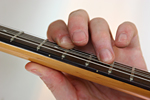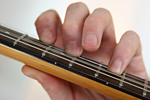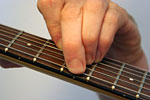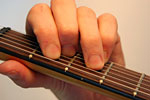Part One: Melody
Focuses on single note soloing. Learn how to effortlessly solo through complex chord changes.
Free Jazz Guitar Lessons with Chris Standring
Let's look at the key of C major again and see how triads are built on every degree of the scale. Remember when we discussed that chord are built up in 3rds?

You will see in the example above that chord vii is a diminished triad. A diminished triad is made up of two minor third intervals. The 3rd is minor and the fifth is also flattened: Let's look at that on the fretboard. Let's take a simple B minor triad at 7th position:
B
minor triad


The red X above shows how a full B minor barre chord might be played at this position (6th string root). The inner notes I have focused on show the B minor triad. Now, a diminished triad is formed by flattening the 5th degree of the chord like this:
B
diminished triad


Now here is where it gets just a little bit tricky. If we were to add another 3rd on top of every chord in this scale sequence, the following chords would then present themselves to us:

All
of these chords above are very familiar to you as we have covered all
of them except chord 7. You will see that by adding another 3rd to each
chord, we get added 7ths and as you know our key signature dictates
whether these chords are major or minor etc. Chord 7, with our newly
added 3rd built on top presents a new chord: Bminor7(b5). This minor7(b5)
chord is also called a half diminished chord. You may at times
also see this chord notated thus: BØ.
Here are two ways to play a half diminished chord, first with a 6th
string root and then with a 5th string root. You could visualize a B
minor chord as the 'parent chord' of this half diminished chord if it
helps. For instance if you look at the 6th string root voicing below
you can see that where the 2nd, 3rd and 4th finger lie, this would be
where your 1st finger would barre right across the six strings in a
simple B minor barre chord:
Bm7(b5)
(6th string root)


And here it is, a little easier to finger with a fifth string root:
Bm7(b5) (5th string root)


These chords are quite sophisticated and are used often
in Jazz and Bossa Nova a great deal. They are also found in Pop and
R&B ballads. Stevie Wonder loves these chords and uses them all
the time in his songs. Move these two chords chromatically up and down
the neck and get a feel for how they sound at different positions on
the fretboard.
These half diminished chords are very useful in Minor keys. A half diminished
chord is a great way to prepare a dominant 7th chord going to a minor
chord. It's a very strong cadence. So in A minor, let's say, the dominant
chord would be E7, and to prepare that E7 chord, a half diminished chord
(chord 2 in A minor) would be Bm7(b5).
Free online jazz guitar lessons for beginners, intermediates and advanced.
Online jazz guitar instruction from recording artist Chris Standring
Join The Inside Track membership and get access to all Chris Standring's guitar instructional programs, all in one place.
It has been many years since the first edition of Play What You Hear (originally released in 2000). Now volume two is here with new ideas and concepts, complete with audio, video, traditional notation and TAB throughout. High resolution pdf available for printing the entire program. For intermediate and advanced players.
Focuses on single note soloing. Learn how to effortlessly solo through complex chord changes.
Focuses on chord melody. Learn new harmonic devices and understand chords in a whole new way.
Study Chris Standring's six recorded solos, transcribed with audio and high def video.
Copyright © PlayJazzGuitar.com - All Rights Reserved.